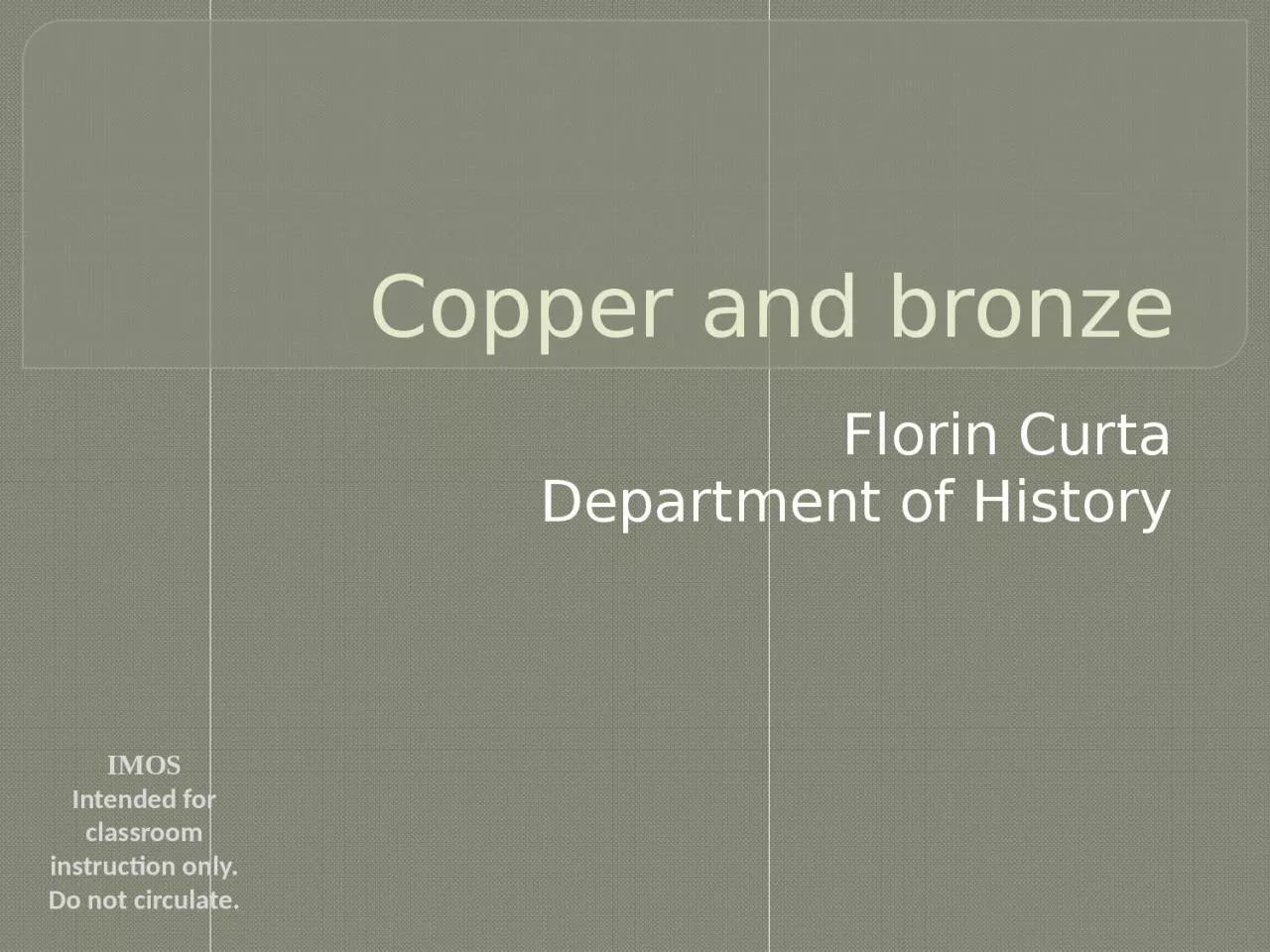

Department of History IMOS Intended for classroom instruction only Do not circulate Who came up with the idea of a Bronze Age Christian Jürgensen Thomsen 17881865 Lucretius ID: 1020325
Download Presentation The PPT/PDF document "Copper and bronze Florin Curta" is the property of its rightful owner. Permission is granted to download and print the materials on this web site for personal, non-commercial use only, and to display it on your personal computer provided you do not modify the materials and that you retain all copyright notices contained in the materials. By downloading content from our website, you accept the terms of this agreement.
1. Copper and bronzeFlorin CurtaDepartment of HistoryIMOSIntended for classroom instruction only.Do not circulate.
2. Who came up with the idea of a “Bronze Age”?Christian Jürgensen Thomsen (1788-1865)Lucretius, de rerum natura v 1283-1287Man's ancient armsWere hands, and nails and teeth, stones too and boughs-Breakage of forest trees- and flame and fire,As soon as known. Thereafter force of ironAnd copper discovered was; and copper's useWas known ere iron's, since more tractableIts nature is and its abundance more.With copper men to work the soil began,With copper to rouse the hurly waves of war,To straw the monstrous wounds, and seize awayAnother's flocks and fields. For unto them,Thus armed, all things naked of defenceReadily yielded. Then by slow degreesThe sword of iron succeeded, and the shapeOf brazen sickle into scorn was turned:With iron to cleave the soil of earth they 'gan,And the contentions of uncertain warWere rendered equal.(translation by William Ellery Leonard, 1916)IMOSIntended for classroom instruction only.Do not circulate.
3. Earliest evidence of the use of copperÇatal Hüyük (ca. 6500 BC)Ötzi (ca. 3300-3200 BC)IMOSIntended for classroom instruction only.Do not circulate.
4. Native copperno impurities, so it can be worked out by hammeringIMOSIntended for classroom instruction only.Do not circulate.
5. Working copperCold treatmentannealingIMOSIntended for classroom instruction only.Do not circulate.
6. Copper ores: oxidized and sulphidesMalachite (CuCO3)Fahlerz (Cu2SBS3)IMOSIntended for classroom instruction only.Do not circulate.
7. Copper smeltingCruciblefurnaceTimna (Israel), 4460-4240 BCIMOSIntended for classroom instruction only.Do not circulate.
8. Copper ingotsDevon coast (England)Hazor (north Israel)IMOSIntended for classroom instruction only.Do not circulate.
9. Copper and bronzeMelting pointHardness (brinell scale)Copper: 1083 centigrades (1981 F)A 10 percent tin-copper alloy: 1000 centigrades (1832 F)Copper: between 50 HB (cast) and 100 HB (cold worked)A 10 percent tin-copper alloy: between 100 HB (cast) and 230 HB (cold worked)IMOSIntended for classroom instruction only.Do not circulate.
10. Sources of tin (tinstone, SnO2)IMOSIntended for classroom instruction only.Do not circulate.
11. Uluburun, southern coast of TurkeyIMOSIntended for classroom instruction only.Do not circulate.
12. A protoindustrial center: Hacinebi (Eastern Turkey)IMOSIntended for classroom instruction only.Do not circulate.
13. Bronze-Age hoards and burialsSibiu (romania)Mycenae (greece)IMOSIntended for classroom instruction only.Do not circulate.
14. Pulverbatch (England)Dongxiafeng (China)MouldsIMOSIntended for classroom instruction only.Do not circulate.
15. Lost wax castingIMOSIntended for classroom instruction only.Do not circulate.
16. Wire drawingThin sheetRepousséNew techniquesIMOSIntended for classroom instruction only.Do not circulate.
17. Bronze-Age smiths or aristocrats?Weissig (Germany)Villena (spain)IMOSIntended for classroom instruction only.Do not circulate.
18. Mythological smiths: the dwarves of NidavellirIMOSIntended for classroom instruction only.Do not circulate.
19. The triple importance of metallurgy:technological: a series of new skills became necessary and commonplaceEconomic: raw materials and finished products became abundantly available3. social: the effects of new artifact types introduced the possibility of new scales of value and new possibilities for the demonstration of social divisionsIMOSIntended for classroom instruction only.Do not circulate.